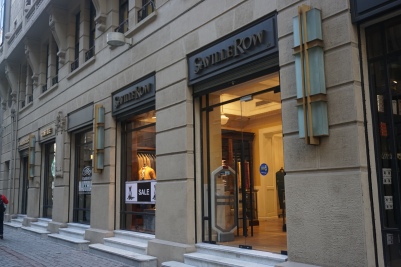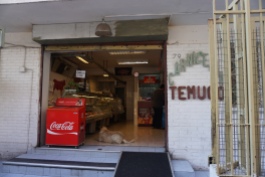For the past few weeks, we had been travelling across so many different landscapes, met so many different types of people, and being so different to what we were used, we had got used to being ‘proper travellers’. All that kinda changed when we hit Santiago!
As soon as we got out of our minibus that took us to Santiago, the hustle and bustle of the city hit us straight away. People everywhere! Horns beeping! Big buildings! In the space of a few hours we had been brought from the calm, yesteryear feel of the Atacama, and to the present day, modern city that was Santiago. Although me and Karina are both used to it, not having that noise and chaos for a few weeks makes you forget about it somewhat. So when we got out on the streets of Santiago, it was definitely a bit strange at first.
And here’s the quick history lesson: as is the case with most South American cities outside of Brazil, Santiago was founded by the Spanish in the name of King Carlos I. In this case, it was founded in 1541 by Pedro de Valdivia, sent to Chile from Peru by Francisco Pizarro (remember him from Lima?), and has been the Chilean capital ever since.
After a quick settling in, we had a day or so to explore Santiago to see what it had to offer. It immediately dawned on me that this was the most well off city we’d come to so far in South America, with the signs of western style consumerism on display everywhere, from clothes to jewellery to food.
We went on a walking tour of the city, run by the ‘Free Walking Tour’ company, and we managed to see most of the main places in Santiago quite easily in an afternoon. The main square, Plaza de Armas was very close by, where we saw the Cathedral, and as it had been with everywhere we’d already been, it was a grand building.
A funny story from the walking tour was that we ended up having three dogs join us on this tour. When the guide stopped to talked, they stopped. And when we started to walk, they’d start walking with us. They enjoyed being around big groups of people we were told, and as was the case so far in South America, the dogs were harmless and very friendly. It was funny seeing them do this though.
The tour took us through various Santiago neighbourhoods, and we got to see some interesting architecture along the way.
We got great views of the city up in Cerro San Cristobal, a hill in the north of the city. In fact, there’s a statue of the Virgin Mary at the top of the hill, within which there’s a chapel where Pope John Paul II once held prayers, so it’s a fairly famous attraction. You could see the whole city from up here against the backdrop of the Andes, a really cool sight, but the skyline had become a bit hazy of late due to pollution, which was a bit of a shame. We had a great time nonetheless.
We had a bit of time to check the Mercado Central, a famous fish market in Santiago, where you could find pretty much any weird and wonderful seafood you could think of. It was voted in the Top 10 Best Food Markets in the world by National Geographic, so we thought we’d check out what the fuss was a about. It wasn’t glamorous, but was definitely interesting. Well worth a visit in the end.
One of the things that our walking tour guide had talked to us about was the controversial history of Santiago and Chile, especially starting in 1973, when the then popular President Salvador Allende was overthrown in a military coup by General Augusto Pinochet. Pinochet ruled from 1973 through to 1990, during which period many of Pinochet’s opponents were arrested, tortured, or just ‘disappeared’. It remains a dark period for many Chileans, especially since it’s still in the memory of most people from there. I was surprised to learn that a very strong ally of Pinochet was Britain’s own Margaret Thatcher, or then again not so surprised. So our guide recommended we go to a museum dedicated to this time period, where they had voice recordings from this period, to TV reporter coverage, to Salvador Allende’s farewell radio speech to the people of Chile, made from inside the Presidential Palace, while General Pinochet’s tanks were just outside the Palace walls ready to complete the coup. Salvador Allende committed suicide shortly after finishing the speech. Walking around this museum was saddening, but a deeply knowledgable experience. Chileans had been through a lot of suppression during this era, and it’s a shame that they never really got to see any justice from this era: General Pinochet was never convicted for any of the crimes he was accused of.
After this very humbling experience, we were headed to the nearby port city of Valparaiso, which actually ended up being one of my favourite places so far in South America.





























sounds very historical. loved reading this. Glad you are enjoying yourselves
LikeLike